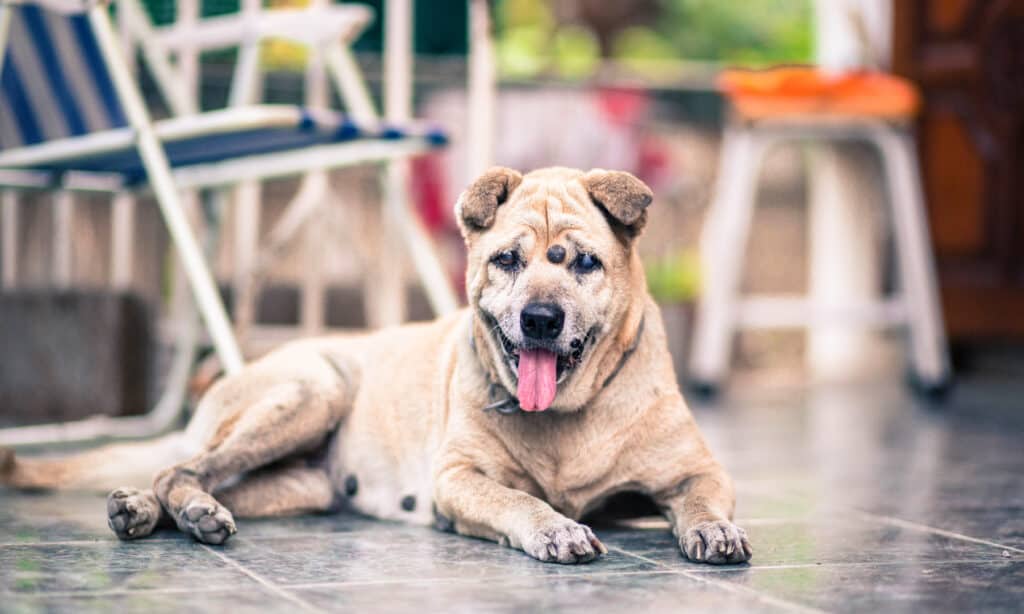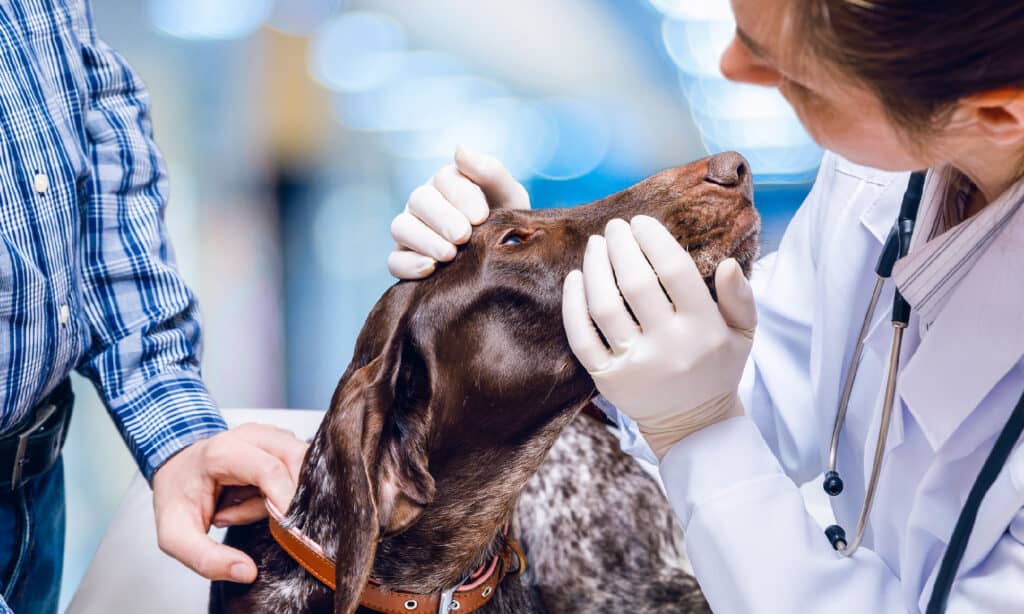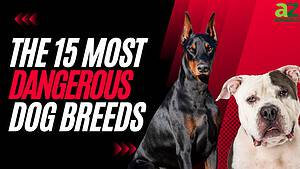Our canine friends are a member of our family, so we get to know everything about them. Whether it is their favorite snacks or how quickly their hair grows each month, we know it all. That’s why you might be shocked to see the sudden growth of a skin tag on their body, especially if you have never seen this type of growth on your dog before.
We want you to be aware of all the details surrounding skin tags in dogs, so let’s break down everything you need to know about these benign growths below!
What Are Skin Tags?

Skin tags are tissue growth on top of the skin.
©Albina Gavrilovic/Shutterstock.com
Before we dive into the details of these strange growths in dogs, we should first answer the question of what a skin tag is in the first place. A skin tag is a growth of tissue that is connected to the body by a stalk-like bridge. Skin tags on the surface of the skin can be either long and skinny or short and nodular, but they can occur virtually anywhere on the body. They are most often completely harmless and benign, and they are usually just cosmetic issues in dogs. You can find them in adult or senior dogs, but they can occur in any type of canine friend. Once these skin tags do develop, you will notice that they grow slowly.
Can Dogs Get Skin Tags?

Dogs can have skin tags.
©Witthawat/Shutterstock.com
Yes, dogs can get skin tags just like humans can. Their skin tags are usually completely harmless and only serve as a cosmetic issue, so there is typically nothing to worry about if you notice one. While any type of dog can develop a skin tag, they seem to be the most common in Schnauzers, Poodles, Cocker Spaniels, and different types of Terriers.
Where Do Dogs Get Skin Tags?
Skin tags in dogs can develop anywhere on the body, but they seem to be the most common in areas of friction. This means that most dogs will develop skin tags on their neck around where their collar lies, on their chest and abdomen where their skin touches the floor when resting, in their armpit where their skin rubs together as they move, and even on their elbows. While these are the most common areas for skin tags to develop in dogs, they can be found anywhere.
What Causes Skin Tags In Dogs?

Skin tags develop mostly in areas of high friction.
©iStock.com/adogslifephoto
As we mentioned above, skin tags in dogs most often develop in areas of high friction. The frequent rubbing or contact that occurs on certain regions of the body increases the risk of skin tags, and this is the same for humans as well. Areas on the skin with high friction can sometimes experience overactivity of the fibroblasts, which in turn can lead to an overgrowth of fibrous tissue. This is when the skin tag will slowly form, leading to a strange growth on the surface of the dog’s skin.
Is It A Skin Tag Or Something More? When To See The Vet
Skin tags in dogs are usually harmless, but we cannot say the same for other lumps and bumps in dogs. Our canine friends can develop masses that are painful or cancerous in nature, so it’s essential to make sure you are indeed looking at a skin tag in your pup. The only way to rule out other dangerous masses is by having your pup examined by your veterinarian, and performing a skin biopsy if your vet thinks it is necessary. There is no way for us to know exactly what type of growth we are dealing with without veterinary guidance, so we always suggest at least reaching out to your vet to see what they suggest.
Do I Need To Treat My Dog’s Skin Tag?

Follow the advice of your vet to determine if your dog’s skin tag needs treatment.
©iStock.com/Natali_Mis
If skin tags in dogs are usually harmless, does this mean we do not need to treat them? While skin tags in dogs are typically just a cosmetic issue, there are situations in which they become bothersome for the dog. To make sure you know when you should pursue treatment for your dog’s skin tag, let’s break down a few skin tag situations that warrant treatment below.
Due to the fact that many dogs with skin tags will develop them in high-friction areas, this often means that their skin tags will endure this same friction. This is especially common with skin tags on the abdomen or chest, as they will be rubbed against the ground each time a dog lays down. This can lead to irritation around the skin tag, and even a localized infection if bacteria is introduced to the area. If your pup’s skin tag is constantly becoming infected, it might be time to have it removed.
Not only can skin tags become infected if they are constantly being rubbed and irritated, they can also form in bothersome areas. For example, some dogs will develop skin tags on their eyelids or other surrounding areas, leading to frequent eye irritation as the skin tag grows. In these situations, many vets will suggest having the skin tag removed.
If your vet does recommend having your dog’s skin tag removed, there are a couple of ways they can move forward with removal. Your vet can either surgically remove the skin tag with local or inhalant anesthesia, or they can freeze the skin tag off with cryotherapy. Every treatment route will vary based on the skin tag location and tolerance of your dog, so we suggest following your vet’s recommended treatment plan.
Do Skin Tags In Dogs Grow Back?
While skin tags on your dog should not grow back, they might get another skin tag in that location if it is due to high friction. This might just mean that your pup is prone to getting skin tags in that area, so you may just need to keep a close eye on the area for any new growth or skin irritation. Due to the fact that skin tags are benign, you don’t need to worry about a dangerous lump growing back as you would with other concerning dog lumps.
Conclusion
Skin tags in dogs are harmless lumps that you do not often have to worry about often. If your dog’s skin tag ever becomes irritated or seems to be getting in the way of your dog’s comfort, we suggest reaching out to your vet for guidance on how to remove it safely.
Up Next:
The photo featured at the top of this post is © Witthawat/Shutterstock.com
Ready to discover the top 10 cutest dog breeds in the entire world?
How about the fastest dogs, the largest dogs and those that are -- quite frankly -- just the kindest dogs on the planet? Each day, AZ Animals sends out lists just like this to our thousands of email subscribers. And the best part? It's FREE. Join today by entering your email below.
Thank you for reading! Have some feedback for us? Contact the AZ Animals editorial team.






